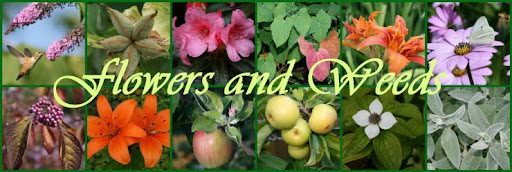My espalier fruit trees are a continual delight to me, as well as to my garden and garden blog visitors. All three are in the horizontal cordon espalier form, and all of them feature 3 different varieties of the same fruit, one on each horizontal level. I have had my apple and asian pear espaliers about 7 years now, in which time their branches have grown from about 1 1/2 feet long to about 8 feet long. My european pear is quite new, added only 4 years ago.
Here is my apple espalier tree, with a closeup of 2 of the varieties of apples:
And here is my espalier asian pear, with a closeup of all 3 varieties of asian pears:
For me, the process of planting and getting them set up was an interative approach, but some of the lessons I've learned are :
1. Leave lots of room for horizontal growth of the branches. I like the look of mine at 8 feet (16 overall), since this is the length of my cedar fence panels. But I think the branches could easily grow to 12 feet or more, with adequate supports.
2. If you plant against a wall or fence, leave room behind for access. Mine are planted about 12" from the fence, and this provides good access to reach behind, to trim branches, etc.
3. You don't need a fence behind. At the UBC Botanical gardens, there are some wonderful examples of espaliers growing beside a path in the food garden, and the espaliers themselves form a fence. But if you have a fence or wall available, it helps to provide reflective heat for fruit production.
4. Provide adequate supports for the branches. Mine are a thick vinyl-coated copper wire ( roughly equivalent to a clothesline), tied to landscaping posts through eyelet hooks. But over time the eyelet hooks are coming loose, so if I re-tied them, I would tie them directly around the posts, and bend a nail over them to keep them from sliding up/down the post.
5. Be diligent in pruning. Over time you will learn to recognize fruit-bearing spurs (which are compact) and the vertical growth which need to be trimmed back aggressively, to allow the tree to put its energy into fruit rather than branch development. I prune them at various times during the year, mostly in spring and summer, when the growth is quite vigorous, and needs to be diverted to the fruit.
6. Be diligent in thinning the fruit. Yes, the fruit is so plentiful, that it needs to be pruned, in order to allow the fruit to develop. Best not to leave more than one or two per fruiting spur, and not closer than 6" apart. This is the task I find the hardest, and I tend to leave too much fruit, creating undue strain on the tree, and ending up with fruits that don't ripen as quickly or fully as they could.
But most of all, I've learned with all of my fruit trees :
7. Start now! Trees are an excellent investment, and grow every year, so if you are thinking about a purchase, don't put it off another year. Prepare your hole, and head to the nursery! The best stock arrives (usually bareroot) in late winter/early spring, so it is that time, or soon will be!
PS. Come join in the 4th of each month with your own "You Can Grow That" post, at Whole Life Gardening.









